Currency - Classic Style - The U.S. $2 Bill -- The History, The Myths, The Legends
So many people here on SteemIt talk about currency, albeit cryptocurrency, that I was inspired to write this post about an unusual family member in the U.S. Currency system: the $2 bill.
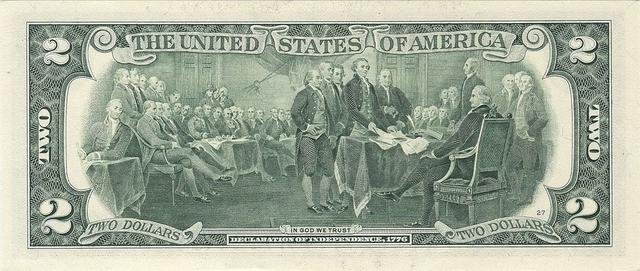
We recently received payment at a comic convention in $2 bills. One is from the 1976 series and the other is from the 2013 series. It is such an underused denomination that many think it is no longer even in circulation. Of course this leads to occasional issues where merchants refuse the bills or, even worse, call the police thinking they've encountered a counterfeiter. Even sadder is the fact that people have been arrested for trying to use perfectly legal money.
The Larger Note History
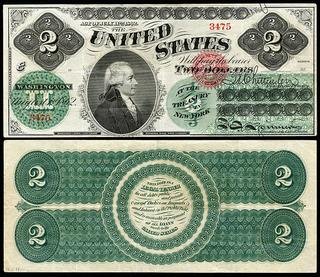
Pictured on the front of the note is the first U.S. Secretary of the Treasury, Alexander Hamilton. He is currently on the U.S. $10 bill. Hamilton may be well remembered as the opponent of then-Vice President Aaron Burr in their famous duel on July 11, 1804 in Weehawken, New Jersey. Hamilton shot first and hit a tree behind Burr, perhaps in an attempt to simply end the duel. Burr then shot and mortally wounded Hamilton, who died the following day. Of course he is now immortalized in the Lin-Manuel Miranda musical Hamilton that has been all the rage since 2015.
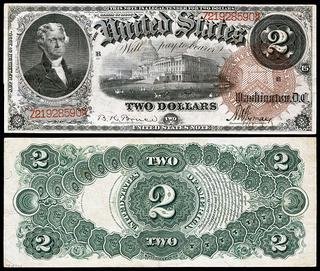
Silver Certificates
In 1873, The Fourth Coinage Act put the U.S. on what is known as the "Gold Standard." This enraged many who, up until then, were able to turn their silver into unlimited money. The act also made it so there would be a strict limit on the amount of money produced. In 1878 the Silver Certificate was created to appease those "Silverites." The Silver Certificates were redeemable for their face value in silver dollar coins. For one full year, 1967-1968, you could actually even trade them for raw silver bullion. Then in 1968, the Silver Certificates became exchangeable only for Federal Reserve Notes of the same value.
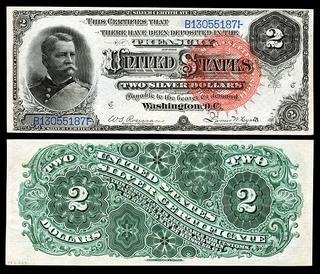
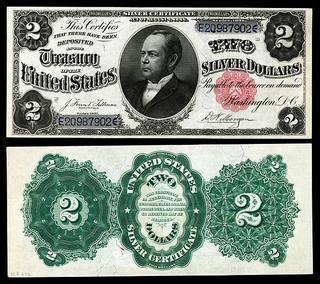
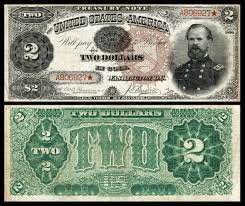
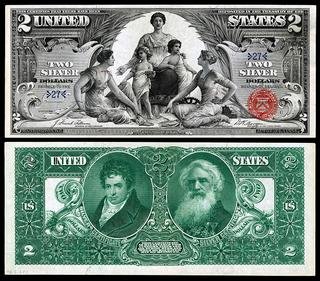
The $2 certificate seen here is titled, "Science Presents Steam and Electricity to Commerce and Manufacture." Depicted on the back of this bill are famous inventors Robert Fulton and Samuel Morse. Fulton created the first working steam engine, while Morse contributed to the invention of the single-line telegraph and of course to the code named for him.
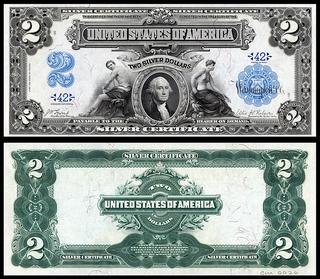
The final large note $2 bill was actually a Federal Reserve Bank Note (FRBN) issued in 1918. This is different than today's better-known Federal Reserve Note (FRN). The FRBN is backed by one specific federal bank of the twelve, whereas the FRN is backed by all of them collectively. This meant that the notes were the sole responsibility of the issuing Federal Reserve Bank and could only be redeemed at that issuing bank.
The note again pictured Thomas Jefferson on the front along with the city of the Federal Bank that issued it. On the back was a World War I battleship. This is one of the actually valuable $2 bills. Many believe that all are more valuable than their face value because they are rare, but this just isn't the case. The 1918 Battleship, though, can sell for upwards of $2,000 and even a beat-up, crinkled one could go for around $250. It was truly a unique design, and with individual banks issuing them, it did make some of them rather scarce. It is often listed as a favorite of collectors. In my research, the specific battleship depicted was never identified.
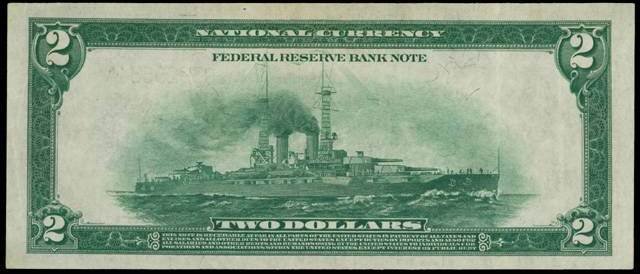
The Smaller Notes
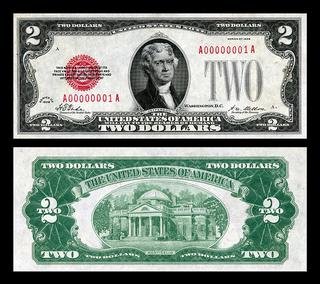
The $2 bill shown in this photo is actually on display in the Smithsonian Institute. If you look at the serial number, you will notice it was the first-ever issued $2 of this size and design.
The Modern $2 Bill

While the bills were special since they celebrated the country's 200th birthday, and you could even take the first-day issued bills to your local post office to have the date "APR 13 1976" stamped on it, they were anything but rare. The 1976 series of $2 bills printed a total of nearly 600 million notes.
Due to people hoarding the bills and the lack of popularity in circulation among the others, the Treasury Department didn't feel a need to print more for quite some time. This is one of the leading reasons people think $2 bills are no longer in circulation. In fact, it wasn't until 1996 that more $2 bills were printed. These were marked as the 1995 Series, and between 1996 and 1997, there were about 150 million bills printed. All of that series was printed in the Federal Reserve District of Atlanta. Then in 2004, the 2003 Series of about 121 million more bills were printed in Minneapolis. From July to September 2006, a 2003A series was printed, this time utilizing all twelve Federal Reserve Banks which printed about 220 million bills in all. In 2012, another short run of about 512,000 bills were printed for the 2009 Series. In 2013, the Atlanta Bank printed about another 44 million bills, which entered circulation in 2014. This is the last time that $2 bills were printed.
The image depicted in engraving plate form on the back of the $2 came from an oil painting on canvas by John Trumbull. The scene was not, as many think, the signing of the Declaration of Independence; instead, it is the drafting of the storied document. To make it fit on the engraving plate, six of the men pictured in the painting (on the left and right edges) had to be left off. On the left, George Wythe (Virginia), William Whipple (New Hampshire), Josiah Bartlett (New Hampshire), and Thomas Lynch, Jr. (Virginia) were dropped, and on the right, Thomas McKean (Delaware) and Phillip Livingston (New York) were removed. There are also a number of signers of the Declaration which are not pictured because Trumbull had no depiction of them to copy. Also, there is little chance that all of these men were ever in any room together, never mind being together in Independence Hall.
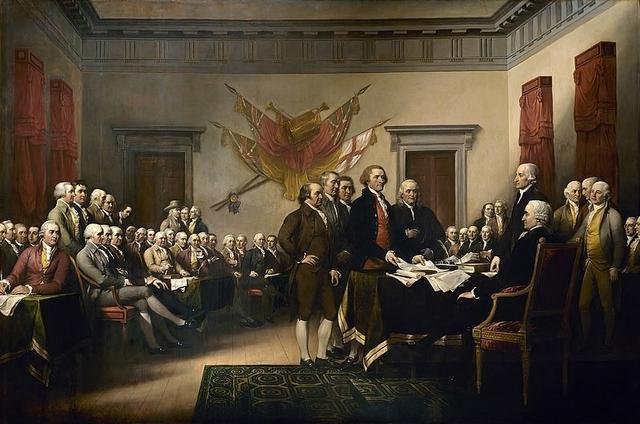
Here are a couple of pictures of the 1976 and 2013 series bills we received at the comic con. I am amazed at how crisp the 1976 bill still is. It is definite proof that people have had these things stashed away for four decades. Honestly, if you had both bills in your hands, you would not be able tell which one is 41 years old and which one is 4 years old.
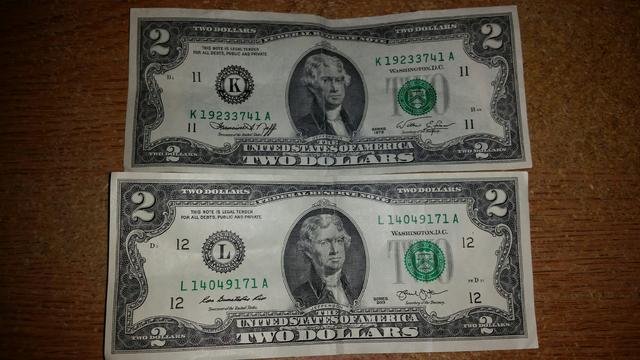
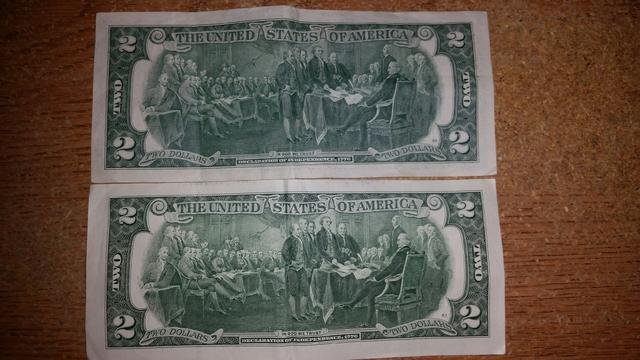
The Myths and The Legends
I had always been told that the $2 bill was rare and worth something. Unfortunately, they really aren't worth all that much -- with a few exceptions. Most of the ones in circulation are basically worth face value. Even the uncirculated bills are generally only worth maybe twice face value. Again, there are some exceptions, so always check the value of any you may have just in case.
One thing that is not a myth is that any merchant can legally deny a $2 bill, but that is only because they have the right to deny ANY currency. It is not specific to the $2 bill.
If you come across a $2 bill that has one of the twos torn off the corner, there is a good chance that bill has been to the horse track. Back in the 1930s, it was common for people to use them at the horse track since the standard bet is $2. Often times people would tear off the corner because it was supposed to be good luck.
This belief of good luck extends away from the track as well. Some believe that you can tear each of the corners off, but once the fourth corner is gone, so is all of the luck.
If you find one that has an orange tiger paw stamped on it, that probably means that your $2 bill has attended a Clemson Tigers away game. In 1977, Georgia Tech threatened to stop playing Clemson. Fans of the team who attended the away games at Georgia Tech started taking $2 bills with them and stamping the orange paw so that local merchants could see how good they were for the economy. Fans have since continued the tradition in other places as well.
This is something that has been done numerous times as a way to show how much of a difference a group or business can be to a local economy.
In 1925, the U.S. government attempted to raise the popularity of the $2 bill by enclosing one in the envelope with paychecks of federal employees.
At one point it was believed those that possessed $2 bills consorted with prostitutes because the going rate at the time was $2.
Another assumption made about the bearers of $2 bills was related to election rigging. The men who were hired to go from polling place to polling place to vote fraudulently many times were given $2 bills for each vote. When people saw someone with a bunch of $2 bills in their wallet, they assumed they were one of the voters.
As of late, gun supporters have used the $2 bill as a way to support the Second Amendment .
Similarly, Michigan residents used $2 bills to show their support for the legalization of marijuana.
Some strip clubs now use $2 bills when making change in an attempt to push up the tips for their dancers and waitresses.
Final Thoughts
The $2 bill is the ugly step-child of U.S. currency. It seems it always has been, and probably always will be. Whether they are good luck or bad luck, it doesn't really matter. They are still in circulation, they are still printed occasionally, and they are still legal tender! Your grandparents or parents probably have at least a few of them stashed away somewhere. Why not ask to see them? It is sure to start a fun conversation, and who knows? You might find some Battleships!
Photo Credits:
Wikipedia
The Smithsonian Institute
U.S. Treasury
This post has received a 2.29 % upvote from @upmyvote thanks to: @randomwanderings. Send at least 1 SBD to @upmyvote with a post link in the memo field to promote a post! Sorry, we can't upvote comments.
2.78% @pushup from @randomwanderings